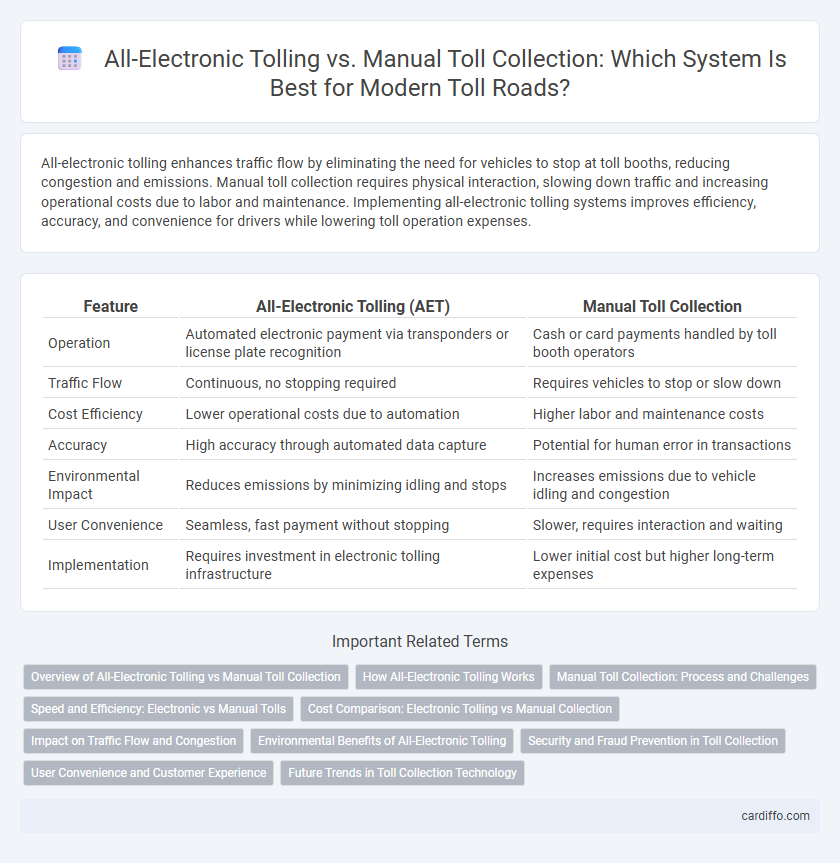All-electronic tolling enhances traffic flow by eliminating the need for vehicles to stop at toll booths, reducing congestion and emissions. Manual toll collection requires physical interaction, slowing down traffic and increasing operational costs due to labor and maintenance. Implementing all-electronic tolling systems improves efficiency, accuracy, and convenience for drivers while lowering toll operation expenses.
Table of Comparison
| Feature | All-Electronic Tolling (AET) | Manual Toll Collection |
|---|---|---|
| Operation | Automated electronic payment via transponders or license plate recognition | Cash or card payments handled by toll booth operators |
| Traffic Flow | Continuous, no stopping required | Requires vehicles to stop or slow down |
| Cost Efficiency | Lower operational costs due to automation | Higher labor and maintenance costs |
| Accuracy | High accuracy through automated data capture | Potential for human error in transactions |
| Environmental Impact | Reduces emissions by minimizing idling and stops | Increases emissions due to vehicle idling and congestion |
| User Convenience | Seamless, fast payment without stopping | Slower, requires interaction and waiting |
| Implementation | Requires investment in electronic tolling infrastructure | Lower initial cost but higher long-term expenses |
Overview of All-Electronic Tolling vs Manual Toll Collection
All-electronic tolling (AET) eliminates cash transactions by using electronic transponders or license plate recognition to collect tolls automatically, enhancing traffic flow and reducing congestion. Manual toll collection requires vehicles to stop or slow down at toll booths for cash or card payments, causing delays and higher operational costs. AET systems improve efficiency, reduce emissions, and lower labor expenses compared to manual toll collection methods.
How All-Electronic Tolling Works
All-electronic tolling (AET) utilizes RFID transponders, license plate recognition cameras, and automated payment systems to collect tolls without requiring vehicles to stop or slow down. Vehicles equipped with transponders are detected as they pass under toll gantries, triggering automatic debit from prepaid accounts, while license plate recognition enables billing for vehicles without transponders through invoice mailing. This technology enhances traffic flow efficiency, reduces congestion, and minimizes operational costs compared to manual toll collection systems.
Manual Toll Collection: Process and Challenges
Manual toll collection involves toll booth operators who collect cash or card payments from drivers, requiring vehicles to stop or slow down significantly. This process often leads to traffic congestion, increased fuel consumption, and higher operational costs due to labor requirements. Manual systems also risk human error and security issues such as cash theft, limiting scalability compared to all-electronic tolling methods.
Speed and Efficiency: Electronic vs Manual Tolls
All-electronic tolling significantly increases speed and efficiency by eliminating the need for vehicles to stop or slow down at toll plazas, enabling continuous traffic flow. Manual toll collection involves physical transactions that cause delays, congestion, and increased fuel consumption. Electronic systems reduce bottlenecks and improve overall roadway capacity, contributing to smoother, faster commutes.
Cost Comparison: Electronic Tolling vs Manual Collection
Electronic tolling systems typically reduce operational costs by eliminating the need for toll booth operators and physical infrastructure maintenance, resulting in long-term savings exceeding 30% compared to manual collection. Manual toll collection incurs higher labor expenses, increased cash handling risks, and slower vehicle processing times, contributing to overall inefficiencies. Studies indicate that implementing all-electronic tolling can lower administrative costs by up to 50%, enhancing revenue accuracy and reducing fraud.
Impact on Traffic Flow and Congestion
All-electronic tolling (AET) significantly improves traffic flow by eliminating the need for vehicles to stop or slow down at toll booths, reducing bottlenecks and congestion during peak hours. Manual toll collection creates physical barriers, causing delays and increased queue lengths that contribute to traffic congestion and higher emissions. AET systems enhance roadway efficiency, enabling smoother and faster traffic movement, which directly mitigates congestion-related issues.
Environmental Benefits of All-Electronic Tolling
All-electronic tolling (AET) significantly reduces vehicle emissions by eliminating the need for cars to stop and idle at toll booths, thereby improving air quality. The continuous flow of traffic under AET systems lowers carbon dioxide and nitrogen oxide outputs compared to manual toll collection, which causes frequent acceleration and deceleration. Studies indicate that AET contributes to a notable decrease in greenhouse gas emissions, supporting environmental sustainability goals in transportation infrastructure.
Security and Fraud Prevention in Toll Collection
All-electronic tolling enhances security by minimizing physical interaction and reducing cash handling, which lowers the risk of theft and counterfeit currency. Advanced encryption and real-time transaction monitoring strengthen fraud detection, preventing toll evasion and unauthorized access. In contrast, manual toll collection is more vulnerable to human error and manipulation, increasing potential losses from fraud and security breaches.
User Convenience and Customer Experience
All-electronic tolling significantly enhances user convenience by eliminating the need to stop for cash payments, reducing traffic congestion and wait times. This seamless process improves customer experience through faster, contactless transactions and automated billing, minimizing human error and increasing accuracy. Manual toll collection often causes delays and requires interaction, which can lead to frustration and a less efficient driving experience.
Future Trends in Toll Collection Technology
All-electronic tolling (AET) systems leverage RFID and license plate recognition to enable seamless vehicle passage, significantly reducing congestion compared to manual toll collection. Future trends emphasize integration with connected vehicle technology and dynamic pricing models, enhancing traffic management and revenue optimization. Advances in AI and blockchain promise increased security and transparency in toll transactions, transforming traditional toll collection frameworks.
All-electronic tolling vs manual toll collection Infographic

 cardiffo.com
cardiffo.com